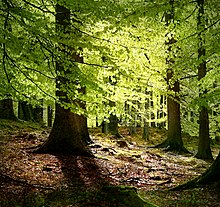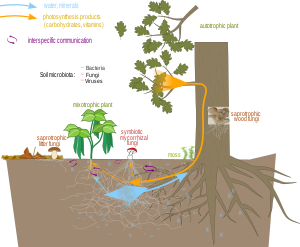Mycorrhiza
A mycorrhiza (from
In a mycorrhizal association, the fungus colonizes the host plant's root tissues, either
Definition
A mycorrhiza is a symbiotic association between a green plant and a fungus. The plant makes organic molecules by
Evolution
Fossil and genetic evidence indicate that mycorrhizae are ancient, potentially as old as the
Types
Mycorrhizas are commonly divided into ectomycorrhizas and endomycorrhizas. The two types are differentiated by the fact that the hyphae of ectomycorrhizal fungi do not penetrate individual cells within the root, while the hyphae of endomycorrhizal fungi penetrate the cell wall and invaginate the cell membrane.[13][14] Endomycorrhiza includes arbuscular, ericoid, and orchid mycorrhiza, while arbutoid mycorrhizas can be classified as ectoendomycorrhizas. Monotropoid mycorrhizas form a special category.
Ectomycorrhiza


Ectomycorrhizas, or EcM, are symbiotic associations between the roots of around 10% of plant families, mostly woody plants including the
Ectomycorrhizas consist of a hyphal sheath, or mantle, covering the root tip and a
Nutrients can be shown to move between different plants through the fungal network. Carbon has been shown to move from
The first genomic sequence for a representative of symbiotic fungi, the ectomycorrhizal basidiomycete L. bicolor, was published in 2008.
Arbutoid mycorrhiza
This type of mycorrhiza involves plants of the Ericaceae subfamily Arbutoideae. It is however different from ericoid mycorrhiza and resembles ectomycorrhiza, both functionally and in terms of the fungi involved.[27] It differs from ectomycorrhiza in that some hyphae actually penetrate into the root cells, making this type of mycorrhiza an ectendomycorrhiza.[28]
Endomycorrhiza
Endomycorrhizas are variable and have been further classified as arbuscular, ericoid, arbutoid, monotropoid, and orchid mycorrhizas.[29]
Arbuscular mycorrhiza

Arbuscular mycorrhizas are formed only by fungi in the
Ericoid mycorrhiza
Ericoid mycorrhizas are the third of the three more ecologically important types. They have a simple intraradical (growth in cells) phase, consisting of dense coils of hyphae in the outermost layer of root cells. There is no periradical phase and the extraradical phase consists of sparse hyphae that don't extend very far into the surrounding soil. They might form sporocarps (probably in the form of small cups), but their reproductive biology is poorly understood.[14]
Ericoid mycorrhizas have also been shown to have considerable
Orchid mycorrhiza
All
Monotropoid mycorrhiza
This type of mycorrhiza occurs in the subfamily
Mutualist dynamics

Mycorrhizal fungi form a
Recent research into

Sugar-water/mineral exchange

The mycorrhizal mutualistic association provides the fungus with relatively constant and direct access to carbohydrates, such as glucose and sucrose.[40] The carbohydrates are translocated from their source (usually leaves) to root tissue and on to the plant's fungal partners. In return, the plant gains the benefits of the mycelium's higher absorptive capacity for water and mineral nutrients, partly because of the large surface area of fungal hyphae, which are much longer and finer than plant root hairs, and partly because some such fungi can mobilize soil minerals unavailable to the plants' roots. The effect is thus to improve the plant's mineral absorption capabilities.[41]
Unaided plant roots may be unable to take up
In some more complex relationships, mycorrhizal fungi do not just collect immobilised soil nutrients, but connect individual plants together by
Mechanisms
The mechanisms by which mycorrhizae increase absorption include some that are physical and some that are chemical. Physically, most mycorrhizal mycelia are much smaller in diameter than the smallest root or root hair, and thus can explore soil material that roots and root hairs cannot reach, and provide a larger surface area for absorption. Chemically, the cell membrane chemistry of fungi differs from that of plants. For example, they may secrete organic acids that dissolve or chelate many ions, or release them from minerals by ion exchange.[48] Mycorrhizae are especially beneficial for the plant partner in nutrient-poor soils.[49]
Disease, drought and salinity resistance and its correlation to mycorrhizae
Mycorrhizal plants are often more resistant to diseases, such as those caused by microbial soil-borne pathogens. These associations have been found to assist in plant defense both above and belowground. Mycorrhizas have been found to excrete enzymes that are toxic to soil borne organisms such as nematodes.[50] More recent studies have shown that mycorrhizal associations result in a priming effect of plants that essentially acts as a primary immune response. When this association is formed a defense response is activated similarly to the response that occurs when the plant is under attack. As a result of this inoculation, defense responses are stronger in plants with mycorrhizal associations.[51]
Resistance to insects
Plants connected by mycorrhizal fungi in mycorrhizal networks can use these underground connections to communicate warning signals.[59][60] For example, when a host plant is attacked by an aphid, the plant signals surrounding connected plants of its condition. Both the host plant and those connected to it release volatile organic compounds that repel aphids and attract parasitoid wasps, predators of aphids.[59] This assists the mycorrhizal fungi by conserving its food supply.[59]
Colonization of barren soil
Plants grown in sterile soils and growth media often perform poorly without the addition of spores or hyphae of mycorrhizal fungi to colonise the plant roots and aid in the uptake of soil mineral nutrients.[61] The absence of mycorrhizal fungi can also slow plant growth in early succession or on degraded landscapes.[62] The introduction of alien mycorrhizal plants to nutrient-deficient ecosystems puts indigenous non-mycorrhizal plants at a competitive disadvantage.[63] This aptitude to colonize barren soil is defined by the category Oligotroph.
Resistance to toxicity
Fungi have a protective role for plants rooted in soils with high metal concentrations, such as
Occurrence of mycorrhizal associations
Mycorrhizas are present in 92% of plant families studied (80% of species),[15] with arbuscular mycorrhizas being the ancestral and predominant form,[15] and the most prevalent symbiotic association found in the plant kingdom.[40] The structure of arbuscular mycorrhizas has been highly conserved since their first appearance in the fossil record,[6] with both the development of ectomycorrhizas, and the loss of mycorrhizas, evolving convergently on multiple occasions.[15]
Associations of fungi with the roots of plants have been known since at least the mid-19th century. However early observers simply recorded the fact without investigating the relationships between the two organisms.[65] This symbiosis was studied and described by Franciszek Kamieński in 1879–1882.[66][67]
Climate change
CO2 released by human activities is causing
Conservation and mapping
In 2021 the Society for the Protection of Underground Networks was launched. SPUN is a science-based initiative to map and protect the mycorrhizal networks that regulate the Earth’s climate and ecosystems. The stated goals of SPUN are mapping, protecting, and harnessing mycorrhizal fungi.
See also
- Effect of climate change on plant biodiversity
- Endosymbiont
- Epibiont, an organism that grows on another life form
- Endophyte
- Epiphyte
- Epiphytic fungus
- Mucigel
- Mycorrhizal fungi and soil carbon storage
- Mycorrhizal network
- Rhizobia
- Suzanne Simard
References
- ^ Deacon, Jim. "The Microbial World: Mycorrhizas". bio.ed.ac.uk (archived). Archived from the original on 2018-04-27. Retrieved 11 January 2019.
- ^ Kirk, P. M.; Cannon, P. F.; David, J. C.; Stalpers, J. (2001). Ainsworth and Bisby's Dictionary of the Fungi (9th ed.). Wallingford, UK: CAB International.
- ISBN 978-981-10-4115-0.
- S2CID 42871574.
- PMID 15998388.
- ^ PMID 11607500.
- ISBN 978-2-7592-2433-3.
- PMID 36175544.
- PMID 35642902.
- PMID 33046698.
- PMID 30024143.
- PMID 29355963.
- ^ Harley, J. L.; Smith, S. E. 1983. Mycorrhizal symbiosis (1st ed.). Academic Press, London.
- ^ a b Allen, Michael F. 1991. The ecology of mycorrhizae. Cambridge University Press, Cambridge.
- ^ S2CID 30468942.
- ^ "Orchids and fungi: An unexpected case of symbiosis". American Journal of Botany. July 12, 2011. Archived from the original on 2011-07-15. Retrieved 24 July 2012.
- PMID 33873790.
- PMID 15720641.
- ^ Rinaldi, A. C.; Comandini, O.; Kuyper, T. W. (2008). "Ectomycorrhizal fungal diversity: separating the wheat from the chaff" (PDF). Fungal Diversity. 33: 1–45. Archived (PDF) from the original on 2011-07-24. Retrieved 2011-05-23.
- S2CID 256845005.
- S2CID 4423207.
- ^ Fungi kill insects and feed host plants BNET.com
- S2CID 4418192.
- PMID 27569718.
- PMID 18322534.
- PMID 33046698.
- S2CID 33371246.
- ^ "Some plants may depend more on friendly fungi than own leaves: Study". Business Standard. Press Trust of India. 20 October 2019.
- ISBN 978-0-660-19087-7. Archived from the originalon 2007-12-25.
- PMID 28087942.
- S2CID 44812991.
- S2CID 4319766.
- ^ International Institute for Applied Systems Analysis (2019-11-07). "Plants and fungi together could slow climate change". phys.org -us. Retrieved 2019-11-12.
- S2CID 4416663.
- doi:10.1071/BT02020.
- PMID 33873410.
- ^ Trappe, J. M. (1987). "Phylogenetic and ecologic aspects of mycotrophy in the angiosperms from an evolutionary standpoint". In Safir, G. R. (ed.). Ecophysiology of VA Mycorrhizal Plants. Florida: CRC Press.
- PMID 24824576.
- PMID 30271996.
- ^ PMID 16153162.
- PMID 16843567.
- PMID 17083683.
- ^ Hogan, C.M. (2011). "Phosphate". In Jorgensen, A.; Cleveland, C.J. (eds.). Encyclopedia of Earth. Washington DC: National Council for Science and the Environment. Archived from the original on 2012-10-25.
- ^ Elkan, D. (21 April 2004). "Slash-and-burn farming has become a major threat to the world's rainforest". The Guardian.
- ^ "What is Inga alley cropping?". rainforestsaver.org. Archived from the original on 2011-11-01.
- .
- PMID 17468111.
- ISBN 978-0-13-094117-6. Archived from the originalon June 23, 2010.
- ^ "Botany online: Interactions - Plants - Fungi - Parasitic and Symbiotic Relations - Mycorrhiza". Biologie.uni-hamburg.de. Archived from the original on 2011-06-06. Retrieved 2010-09-30.
- S2CID 25190159.
- S2CID 12918193.
- PMID 29382946.
- ISBN 1-4020-4445-3.
- ^ "Dr. Susan Kaminskyj: Endorhizal Fungi". Usask.ca. Archived from the original on 2010-11-04. Retrieved 2010-09-30.
- ^ "Dr. Davies Research Page". Aggie-horticulture.tamu.edu. Archived from the original on 2010-10-19. Retrieved 2010-09-30.
- JSTOR 2557434.
- S2CID 84997899.
- S2CID 8572482.
- ^ PMID 23656527.
- PMID 25421970.
- ^ "Root fungi turn rock into soil". Planet Earth Online. 3 July 2009. Archived from the original on 2009-07-13.
- .
- ^ ISBN 978-0-521-78910-3.
- S2CID 23867901.
- .
- S2CID 3162281.
- ^ Kamieński, Franciszek (1885). "Über die auf Wurzelsymbiose beruhende Ernährung gewisser Bäume durch unterirdische Pilze" [On the nourishing, via root symbiosis, of certain trees by underground fungi]. Berichte der Deutschen Botanischen Gesellschaft (in German). 3: 128–145. From p. 129: "Der ganze Körper ist also weder Baumwurzel noch Pilz allein, sondern ähnlich wie der Thallus der Flechten, eine Vereinigung zweier verschiedener Wesen zu einem einheitlichen morphologischen Organ, welches vielleicht passend als Pilzwurzel, Mycorhiza bezeichnet werden kann." (The whole body is thus neither tree root nor fungus alone, but similar to the thallus of lichens, a union of two different organisms into a single morphological organ, which can be aptly designated as a "fungus root", a mycorrhiza.)
- S2CID 34893610.
- PMID 19190704.
- PMID 14739273.
- ^ Xavier, L. J.; Germida, J. J. (1999). "Impact of human activities on mycorrhizae". Proceedings of the 8th International Symposium on Microbial Ecology.
External links
- International Mycorrhiza Society International Mycorrhiza Society
- Mohamed Hijri: A simple solution to the coming phosphorus crisis video recommending agricultural mycorrhiza use to conserve phosphorus reserves & 85% waste problem @Ted.com
- Mycorrhizal Associations: The Web Resource Comprehensive illustrations and lists of mycorrhizal and nonmycorrhizal plants and fungi
- Mycorrhizas – a successful symbiosis Biosafety research into genetically modified barley
- MycorWiki a portal concerned with the biology and ecology of ectomycorrhizal fungi and other forest fungi.
